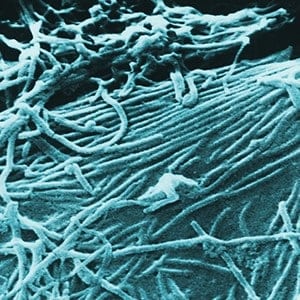A new study has found it is possible to distinguish between different hemorrhagic fevers, including Marburg (Ebola cousin) and Lassa before the person becomes symptomatic.
The study, which appears in the journal BMC Genomics will allow for the development of better diagnostics, especially during the early stages of disease, when treatments have a greater chance of being effective.
Hemorrhagic fevers include Lassa, which is endemic in Western Africa and Marburg, which causes sporadic outbreaks in Africa associated with high rates of mortality. The early symptoms of these viruses (fever, flu-like symptoms) are not unique, making it difficult to diagnose properly. More disease-specific symptoms and the ability to spread the virus from person to person, do not begin until virus has accumulated in the blood. Current diagnostics detect the virus after it spills out of primary sites of infection into the blood. The ability to identify the infection prior to this point would significantly aid early intervention and containment, and could improve outcomes.
Researchers from Boston University School of Medicine (BUSM) approached the diagnostic dilemma by trying to “see” infection prior to the point where viruses enter the blood stream. Collaborating with researchers at the U.S. Army Medical research Institute (USAMRIID), they used two experimental models: one that had involved Lassa virus, and one that involved Marburg virus infection. The researchers extracted genetic material (RNA) from a sample of white blood cells from each infection group at multiple times after the models were infected. Using next-generation sequencing techniques, gene expression changes in hosts cells that “recognize” early stages of infection were identified. This was seen prior to clinical symptom onset and before the models became infectious.
According to the researchers, distinguishing between these viruses early can guide treatment and containment efforts. “The ability to distinguish between different types of infection before the appearance of overt clinical symptoms has important implications for guiding triage and containment during epidemics,” explained corresponding author Nacho Caballero, a PhD candidate at Boston University School of Medicine (BUSM). “We hope that our study will help in the development of better diagnostics, especially during the early stages of disease, when treatments have a greater chance of being effective,” he added.
As exciting as the prospect of this testing is, the research team is setting a realistic time line. “We want to stress that this is not a finding that can be translated into a test tomorrow. This study supports the idea that early markers of infection are there, but significant work will still need to be done to extend these findings,” said Caballero.


